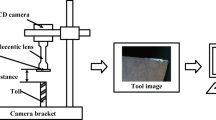Abstract
The object extraction of a debris image is an important basic task in identifying wear particles in ferrographic analysis. However, there is some difficulty in object extraction because of noise jamming in the original debris image. In the present study, two methods of image enhancement—weighted mean filtering and adaptive median filtering—were applied in order to improve the image quality. Then, the adaptive thresholding selection method was used, which is based on an improved debris image. Finally, the effective segmentation of the debris image and the automatic extraction of debris objects were realized. At the same time, targetting the characteristics of low proportion of an object in the total image, a novel method of adaptive thresholding selection was put forward, which is based on the Ostu thresholding method. The segmentation results along with the debris image prove that the current method can give more precise and accurate segmentation of objects than the classical methods. The results also showed that methods in the present paper were concise and effective, which provides an important basis for the further study of debris recognition, fault diagnosis, and condition monitoring of machines.
Similar content being viewed by others
References
Q. M. Yang, Wear Particles Analysis—Wear Particles Atlas and Ferrography (China Railway Press, Beijing, 2002).
Wear Particle Atlas: Free Metal Wear Particles Steel and Steel Based Alloys, Ed. by E. R. Bowen and V. C. Westcott (Foxboro Analytical, Burlington, MA, 1982).
J. K. Beddow, S. T. Fong, and A. F. Vetter, “Morphological Analysis of Metallic Wear Debris,” Wear 58, 201–211 (1980).
B. J. Roylance, J. A. Williams, and R. Dwyer-Joyce, “Wear Debris and Associated Wear Phenomena—Fundamental Research and Practice,” Proc. Instn. Mech. Engrs., J. Eng. Tribology 214, 79–105 (2004).
Z. Peng and T. B. Kirk, “Computer Image Analysis of Wear Debris in Three-Dimensions for Machine Condition Monitoring and Fault,” Wear 223, 157–166 (1998).
Z. Peng and T. B. Kirk, “The Study of Three-Dimensional Analysis Techniques and Automatic Classification Systems for Wear Particles,” Trans. ASME, J. Tribology 121, 169–176 (1999).
Z. Peng, T. B. Kirk, and Z. L. Xu, “The Development of Three Dimensional Imaging Techniques of Wear Particles Analysis,” Wear 203–204, 418–424 (1997).
P. Podsiadlo and G. W. Stachowiak, “Characterization of Surface Topography of Wear Particles by SEM Stereoscopy,” Wear 206, 39–52 (1997).
T. B. Kirk, R. V. Anamalay, and Z. L. Xu, “Computer Image Analysis of Wear Debris for Machine Condition Monitoring and Fault Diagnosis,” Wear 181–183, 717–722 (1995).
X. G. Hu, S. Zhan, and S. S. Zheng, “Study of Gray Relational Grade Identification for Ferrography Based on Wear Debris Characteristic Analysis,” Tribotest 11(1), 57–67 (2004).
G. Chen and H. F. Zuo, “Object Extraction of Color Microscope Debris Images Based on Fuzzy Cluster Analysis,” J. Data Acquisition and Processing 16, 286–290 (2001).
D. J. He, N. Geng, and Y. K. Zhang, Digital Image Processing (Xidian University Press, Xidian, 2001).
G. A. Baxes, Digital Image Processing: Principles and Applications (Wiley, New York, 1994).
N. Ostu, “A Threshold Selection Method from Gray-Histogram,” IEEE Trans, System Man Cybernet 8, 62–66 (1978).
X. Wang, Z. Peng, and L. Liu, “An Adaptive Method of Image Segmentation,” J. Beijing Inst. Technol. 23, 521–524 (2003).
Author information
Authors and Affiliations
Additional information
The text was submitted by the authors in English.
Xianguo Hu (born 1963), PhD, is a professor at the School of Mechanical and Automotive Engineering at the Hefei University of Technology, China. He received his BS and MS in Powder Metallurgy Material and Mechanics (Tribology) from the Hefei University of Technology in 1985 and 1988, respectively. His PhD degree was awarded at Szent Istvan University, Hungary, in 2002. As a visiting scientist, he conducted research at the Technical University of Budapest, Hungary, and the Technical University of Berlin, Germany, from 1994 to 1997. His research areas include wear debris analysis, optimal tribological design, friction and wear mechanisms, etc. He is the author or coauthor of more than 100 published technical papers.
Peng Huang (born 1981) is an MS student at the School of Mechanical and Automotive Engineering of Hefei University of Technology, China. His main focus is on wear debris analysis.
Shousen Zheng (born 1963) is an associate professor at the School of Engineering, SunYat-Sen University, China. He received his BS, MS, and PhD in Mechanical Engineering from Hefei University of Technology in 1985, 1988, and 2001, respectively. From 1988 to 2004, he was employed at the Department of Mechanical Engineering at the Hefei University of Technology. In 2005, he moved to the current university. His research interests include computer language, auto CAD/CAM, wear debris analysis, etc. He is the author or coauthor of more than 40 published technical papers.
Rights and permissions
About this article
Cite this article
Hu, X., Huang, P. & Zheng, S. Object extraction from an image of wear particles on a complex background. Pattern Recognit. Image Anal. 16, 644–650 (2006). https://doi.org/10.1134/S1054661806040109
Received:
Issue Date:
DOI: https://doi.org/10.1134/S1054661806040109




